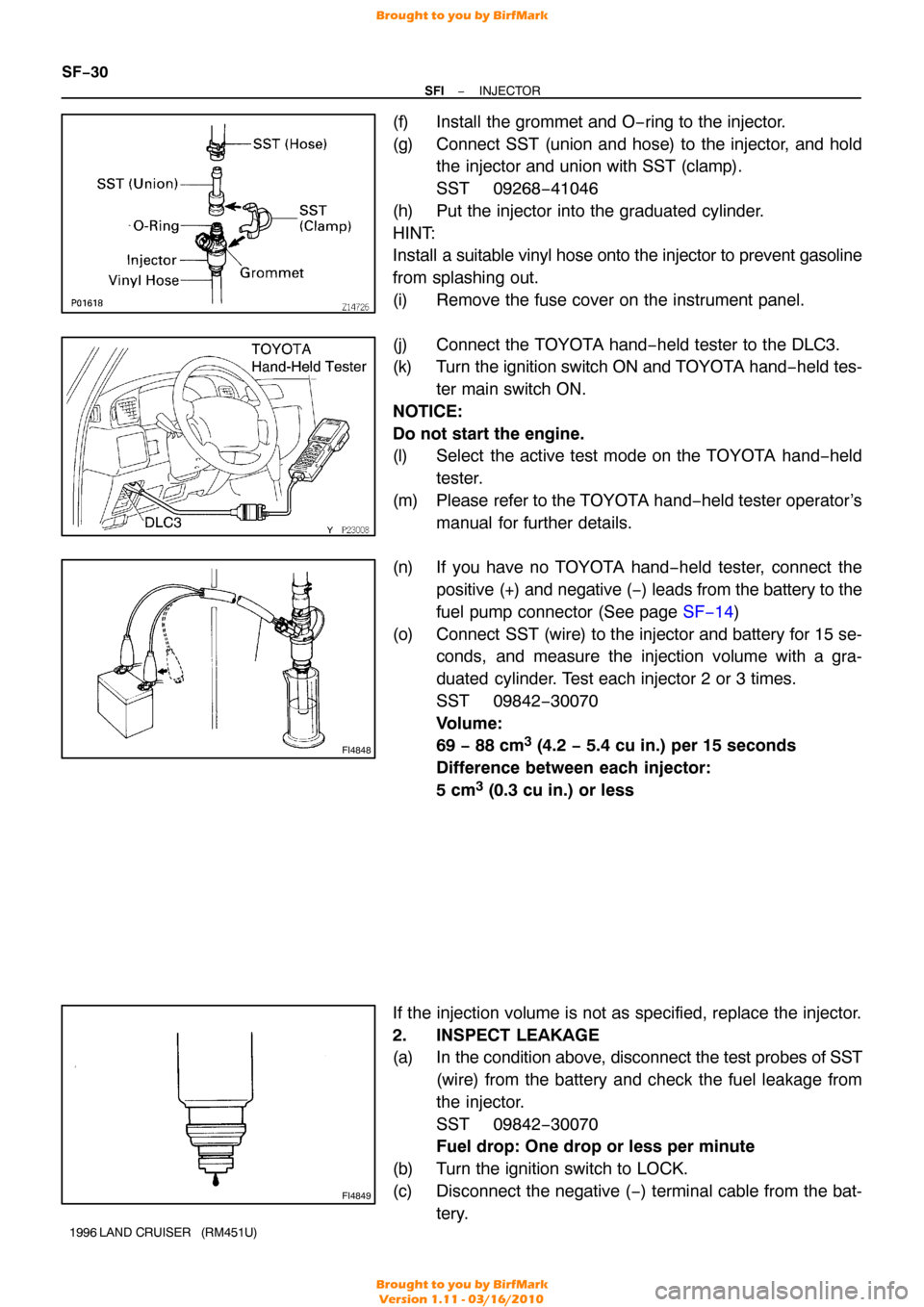Page 489 of 1399

DI−52
−
DIAGNOSTICS ENGINE
1996 LAND CRUISER (RM451U)
2 Check for heated oxygen sensor (bank 1 sensor 1) data.
PREPARATION:
(a) Remove the fuse cover on the instrument panel.
(b) Connect the OBD II scan tool or TOYOTA hand−held tester to the DLC3.
(c) Warm up engine to normal operating temperature.
CHECK:
Read the heated oxygen sensor (bank 1 sensor 1) output voltage and sho\
rt −term fuel trim.
RESULT:
PatternHeated o xygen sensor (bank 1 sensor 1) output voltageShort−term fuel trim
1Lean condition (Changes at 0.55 V or less)Changes at about +20 %
2Rich condition (Changes at 0.4 V or more)Changes at about −20 %
3Except 1 and 2
3 Check for heated oxygen sensor
(bank 1 sensor 1) (See page SF−64 ).
1, 2
3 Check fuel pressure (See page SF−6 ).
NG Check and repair fuel pump, pressure
regulator, fuel pipe line and filter
(See page SF−1 ).
OK
4 Check injector injection (See page SF−29).
NG Replace injector.
OK
Brought to you by BirfMark
Brought to you by BirfMark
Version 1.11 - 03/16/2010
Page 534 of 1399

P22475
BatteryFusible
Link
FL AM2
F7W−R
EA2
W−R
B−R B−R
EA2
B−R
B−W B−W
W−B
Distributor
Ignition
Coil 4
12
EA2
IH1
W−B
8 1
2
Noise
Filter 45
B 3
Igniter Tr2
2
1
IH2 IH2
B−G
B−G
B−Y B−YE4
E4 IGT
IGF Tr15V
ECM
1 3 11
6
IG Switch
1
EC
17 23
14 13
−
DIAGNOSTICS ENGINE
DI−97
1996 LAND CRUISER (RM451U)
DTC P1300 Igniter Circuit Malfunction
CIRCUIT DESCRIPTION
The ECM determines the ignition timing, turns on Tr1 at a predetermined angle ( °CA) before the desired
ignition timing and outputs and ignition signal (IGT) ”1” to the\
igniter.
Since the width of the IGT signal is constant, the dwell angle control circuit in \
the igniter determines the time
the control circuit starts primary current flow to the ignition coil based \
on the engine rpm and ignition timing
one revolution ago, that is, the time the Tr2 turns on.
When it reaches the ignition timing, the ECM turns Tr1 off and outputs the IGT signal ”O”.
This turns Tr2 off, interrupting the primary current flow and generating a high voltage i\
n the secondary coil
which causes the spark plug to spark. Also, by the counter electromotive forc\
e generated when the primary
current is interrupted, the igniter sends an ignition confirmation signal (IGF)\
to the ECM. The ECM stops fuel
injection as a fail safe function when the IGF signal is not input to the ECM.
DTC No.DTC Detecting ConditionTrouble Area
P1300No IGF signal to ECM for 6 consecutive IGT signals during
engine running� Open or short in IGF or IGT circuit from igniter to ECM
� Igniter
� ECM
WIRING DIAGRAM
DI5PQ−02
Brought to you by BirfMark
Brought to you by BirfMark
Version 1.11 - 03/16/2010
Page 540 of 1399
A15825
−
DIAGNOSTICS ENGINE
DI−103
1996 LAND CRUISER (RM451U)
DTC P1500 Starter Signal Circuit Malfunction
CIRCUIT DESCRIPTION
When the engine is cranked, the intake air flow is slow, so fuel vaporization is poor. A rich mixture is therefore
necessary in order to achieve good startability. While the engine is being cranked, the battery positive volt-
age is applied to terminal STA of the ECM. The starter signal is mainly used to increase the fuel inj\
ection
volume for the starting injection control and after −start injection control.
WIRING DIAGRAM
DI968−01
Brought to you by BirfMark
Brought to you by BirfMark
Version 1.11 - 03/16/2010
Page 771 of 1399

EC07H−06
−
EMISSION CONTROL EMISSION CONTROL SYSTEM
EC−1
614
Author�: Date�:
1996 LAND CRUISER (RM451U)
EMISSION CONTROL SYSTEM
PURPOSE
The emission control systems are installed to reduce the amount of HC, CO a\
nd NOx exhausted from the
engine ((3), (4) and (5)), to prevent the atmospheric release of blow −by gas− containing HC (1) and evapo-
rated fuel containing HC being released from the fuel tank (2).
The function of each system is shown in the following table.
SystemAbbreviationFunction
(1) Positive Crankcase V entilation
(2) Evaporative Emission Control
(3) Exhaust Gas Recirculation
(4) Three− Way Catalytic Converter
(5) Sequential Multiport Fuel Injection*PCV
EVAP EGR
TWC SFIReduces HC
Reduces evaporated HC
Reduces NOx
Reduces HC, CO and NOx
Injects a precisely timed, optimum amount of fuel for reduced
exhaust emissions
Remark: * For inspection and repair of the SFI system, refer to the SF section \
in this manual.
Brought to you by BirfMark
Brought to you by BirfMark
Version 1.11 - 03/16/2010
Page 952 of 1399
PP3KU−01
−
PREPARATION SFI
PP−11
60
Author�: Date�:
1996 LAND CRUISER (RM451U)
SFI
SST (Special Service Tools)
09268−41047Injection Measuring Tool Set
(09268−41091)NO.7 Union
(90405−09015)No.1 Union
09268−45012EFI Fuel Pressure Gauge
09631−22020Power Steering Hose Nut
14 x 17 mm Wrench SetFuel line flare nut
09816−30010Oil Pressure Switch SocketKnock sensor
09842−30070Wiring ”F” EFI Inspection
Brought to you by BirfMark
Brought to you by BirfMark
Version 1.11 - 03/16/2010
Page 1215 of 1399
SF1EO−03
−
SFI INJECTOR
SF−29
1996 LAND CRUISER (RM451U)
INSPECTION
1. INSPECT INJECTOR INJECTION
CAUTION:
Keep injector clean of sparks during the test.
(a) Connect SST (union and hose) to the fuel filter outlet with
the 2 gaskets and union bolt.
SST 09268−41046 (90405 −09015)
Torque: 29 N·m (300 kgf·cm, 22 ft·lbf)
(b) Remove the fuel pressure regulator (See page SF−21).
(c) Install the O−ring to the fuel inlet of pressure regulator.
(d) Connect SST (hose) to the fuel inlet of the pressure regu-
lator with SST (union).
SST 09268−41046 (09268 −41091)
Torque: 25 N·m (250 kgf·cm, 18 ft·lbf)
(e) Connect the fuel return hose to the fuel outlet of the pres-
sure regulator.
Brought to you by BirfMark
Brought to you by BirfMark
Version 1.11 - 03/16/2010
Page 1216 of 1399

FI4848
FI4849
SF−30
−
SFI INJECTOR
1996 LAND CRUISER (RM451U)
(f) Install the grommet and O−ring to the injector.
(g) Connect SST (union and hose) to the injector, and hold
the injector and union with SST (clamp).
SST 09268−41046
(h) Put the injector into the graduated cylinder.
HINT:
Install a suitable vinyl hose onto the injector to prevent gasoline
from splashing out.
(i) Remove the fuse cover on the instrument panel.
(j) Connect the TOYOTA hand−held tester to the DLC3.
(k) Turn the ignition switch ON and TOYOTA hand−held tes-
ter main switch ON.
NOTICE:
Do not start the engine.
(l) Select the active test mode on the TOYOTA hand −held
tester.
(m) Please refer to the TOYOTA hand −held tester operator’s
manual for further details.
(n) If you have no TOYOTA hand−held tester, connect the positive (+) and negative (−) leads from the battery to the
fuel pump connector (See page SF−14)
(o) Connect SST (wire) to the injector and battery for 15 se- conds, and measure the injection volume with a gra-
duated cylinder. Test each injector 2 or 3 times.
SST 09842−30070
Volume:
69 − 88 cm
3 (4.2 − 5.4 cu in.) per 15 seconds
Difference between each injector:
5 cm
3 (0.3 cu in.) or less
If the injection volume is not as specified, replace the injector.
2. INSPECT LEAKAGE
(a) In the condition above, disconnect the test probes of SST (wire) from the battery and check the fuel leakage from
the injector.
SST 09842−30070
Fuel drop: One drop or less per minute
(b) Turn the ignition switch to LOCK.
(c) Disconnect the negative ( −) terminal cable from the bat-
tery.
Brought to you by BirfMark
Brought to you by BirfMark
Version 1.11 - 03/16/2010
Page 1312 of 1399

SS1ES−01
−
SERVICE SPECIFICATIONS SFI
SS−11
134
Author�: Date�:
1996 LAND CRUISER (RM451U)
SFI
SERVICE DATA
Fuel pressure
regulatorFuel pressure at no vacuum265 − 304 kPa (2.7 − 3.1 kgf/cm2, 38 − 44 psi)
Fuel pumpResistance at 20°C (68° F)0.2 − 3.0 Ω
InjectorResistance at 20°C (68° F)
Injection volume
Difference between each cylinder
Fuel leakage13.4 − 14.2 Ω
69 − 88 cm3 (4.2 − 5.4 cu in.) per 15 sec.
5 cm3 (0.3 cu in.) or less
1 drop or less per 12 min.
MAF meterResistance (THA − E2) at −20° C (− 4°F)
at 0° C (32° F)
at 20° C (68° F)
at 40° C (104° F)
at 60° C (140° F)
at 80° C (176° F)10 − 20 kΩ
4 − 7 kΩ
2 − 3 kΩ
0.9 − 1.3 kΩ
0.4 − 0.7 kΩ
0.2 − 0.4 kΩ
Throttle bodyThrottle body fully closed angle
Dashpot setting speed
Throttle opener setting speed6°
2,200 ± 300 rpm
700 − 1,000 rpm
Throttle position
sensorClearance between stop screw and lever
0 mm (0 in.) VTA − E2
0.50 mm (0.020 in.) IDL − E2
0.75 mm (0.030 in.) IDL − E2
Throttle valve fully open VTA − E2
− VC − E2
0.2 − 5.7 kΩ
2.3 kΩ or less
Infinity
2.0 − 10.2 kΩ
2.5 − 5.9 kΩ
IAC valveResistance (B1 − S1 and S3, B2 − S2 and S4)
at cold (− 10 − 50 ° C (−50 − 122° F))
at hot (50 − 100°C (122 − 212°F))
15 − 25 Ω
20 − 30 Ω
Fuel pump resistorResistance at 20°C (68° F)0.70 − 0.76 Ω
VSV for fuel pres-
sure controlResistance at 20°C (68° F)37 − 44 Ω
ECT sensorResistance at −20° C (− 4°F)
0 °C (32° F)
20 °C (68° F)
40 °C (104° F)
60 °C (140° F)
80 °C (176° F)10 − 20 kΩ
4 − 7 kΩ
2 − 3 kΩ
0.9 − 1.3 kΩ
0.4 − 0.7 kΩ
0.2 − 0.4 kΩ
EGR gas temp
sensorResistance at 50°C (122° F)
at 100° C (212° F)
150 °C (302° F)64 − 97 kΩ
11 − 16 kΩ
2 − 4 kΩ
Heated oxygen
sensorHeater coil resistance at 20°C (68° F)11 − 16 Ω
Fuel cut rpmFuel return rpm1,200 rpm
Brought to you by BirfMark
Brought to you by BirfMark
Version 1.11 - 03/16/2010